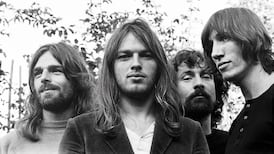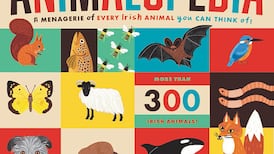Visual Arts: Reviewed Eternal, Paul Nugent, Kevin Kavanagh Gallery until July 9 01-8740064. Maureen Gallace, paintings, Kerlin Gallery until July 2 01-6709093. Filament, Louise Meade, Original Print Gallery until July 12 01-67773657. Fresh Paint, Hillsboro Fine Art until June 25 01-6777905
Paul Nugent's Eternal at the Kevin Kavanagh Gallery comprises just eight smallish, portrait-format canvases. Each painting is monochrome and, at first glance, consists of a flat expanse of colour. There is a dense, luscious quality to the colour, as if it has been built up in successive layers. The overall effect is restrained and austere. As anyone familiar with Nugent's work will know, however, all is not as it seems.
That is, we are not looking at a straightforwardly minimalist body of work. In certain light, and indeed in any light if you look long and patiently, you eyes will spontaneously register the pattern of an underlying image. The image is repeated from painting to painting. It is derived from photographic studies of a statue of the Virgin and Child sited in a church close to Nugent's studio. Suddenly the ecclesiastical character of the colours - including intense red, purple and blue - make sense.
For the artist, the process is part of the work. His various procedures and the paintings that result do not funnel us toward one exclusive reading. Rather they mobilise a number of ideas. A hidden, religious image can be seen as an allegory of content in artworks generally, and a reference to the notional spiritual dimension of abstract art in particular. Then there is the idea of a trace or residue as the image is lost beneath layers of colour. One could infer a note of nostalgia or lament for the certainties of faith. It also appeals to the persistent feeling that there is something beyond what you see in a painting. The show is beautifully installed and the work functions incredibly well as a unit.
Last year Maureen Gallace's show at the Douglas Hyde featured figurative works as well as the wistful, inviting little studies of beach houses in and out of season with which the Irish audience was already familiar. The mood of her studies of people - dreamy, informal, spare - was consistent with that of the landscapes, with one obvious difference. That is, we never see people in the landscapes, even though houses are often their main subject.
This time, in her Kerlin Gallery show, we are back to un-peopled landscapes, to a magical realm of appealing cottages and roads to the beach, summer and winter, entered via the surprisingly small underpass on the Merritt Parkway. If there were people in the images, perhaps we wouldn't be so inclined to feel that the spaces they make are for us. Discussion of Gallace's work often comes around to the strange, deserted air of the settings, and the curious lack of doors and windows in some of her buildings.
Does all of this amount to something like existential unease, a subtext of anxiety? Despite a conceivable relationship to the well-tried American narrative genre in which nastiness lurks beneath the facade of normality, à la David Lynch and many others, there does not really seem to be a dark side to Gallace's idyllic world. Somehow it's not too sweetly idyllic, and she never falls into the trap of sentimentality. A degree of restraint and even astringency allows her to get away with it, so to speak. She has also become exceptionally adept at elegantly concise descriptive painting.
Louise Meade's second solo show at the Original Print Gallery, Filament, is, like her first, subtle but visually rich in a quiet, restrained way. Her prints - they are etchings but many if not all are apparently worked as monoprints - are linked by a fluid theme: water and other, including bodily, fluids. Several of her beautifully textured surfaces recall microscopic views of liquid, the way a droplet of water is revealed to be brimming with all sorts of unsuspected life forms, for example, or the way tiny organisms turn out to have elaborate structural patterns.
Certainly the petri dish and the glass slide come to mind in relation to a world of smears, drips and dots. A press release mentions the word "forensic" and the visual language does suggest evidence, with its evocation of genetic markers and comparative patterns. It suggests it in terms of mood or general atmosphere rather than obviously, just as you could say the show's title surely refers to the idea of a delicate trace, or a tenuous line of evidence, something glimpsed after prolonged and careful observation.
Fresh Paint at Hillsboro Fine Art marshals work by four younger painters. Fiona Dowling's casual narratives deal in a mildly self-deprecating way with memory and imagination. She specialises in images within images, as jokey asides undermine the pictorial correctness of supposedly dominant images. Temperamentally, Eoin O'Connor is quite similar in that he makes gently understated, small-scale mixed-media pieces that have a laid-back, improvisational tone but usually carry a slight sting in the tail.
Natalia Black's thickly worked, kaleidoscopic abstracts featuring banded patterns of bold colour refer to music and the layered strata of landscape sections. Hugh McCarthy is a very capable painter who makes complicated pattern-based compositions using a range of highly stylised graphic symbols. These symbols recall 1960s psychedelia, which gives his work a retro feel and means, oddly enough, that it is right up to the minute, fashion wise.











